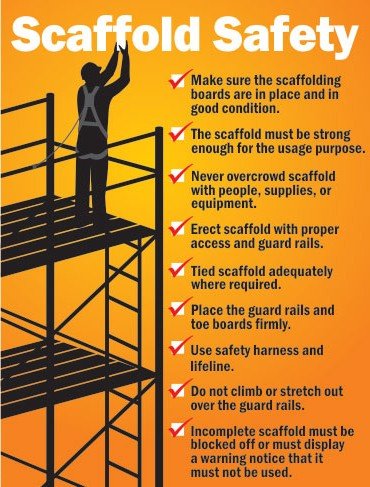
Introduction to Scaffolding Safety
Scaffolding is a temporary structure used in construction to support people and materials while work is being carried out on a building or other tall structure. Scaffolding is often used to allow workers to reach higher levels of a building or structure, and it is important that it is used correctly to prevent accidents and injuries.
In this Toolbox Talk, we will discuss the importance of scaffolding safety and the steps that can be taken to ensure that scaffolding is used correctly and safely.
Scaffolding Standards and Design
One of the most important aspects of scaffolding safety is to ensure that the scaffolding is designed and constructed to the appropriate safety standards. Scaffolding should be designed and installed by a qualified and experienced professional who follows all relevant safety standards and regulations. A well-designed scaffold system will provide a safe and secure platform for workers to carry out their tasks.
Inspection
It is crucial to inspect scaffolding before each use to ensure that it is safe and secure. A daily inspection should be performed to check the guardrails, connectors, fastenings, footing, tie-ins, and bracing. If any component is damaged, it should be repaired or replaced immediately. The inspection should be performed by a competent person with experience in scaffolding safety.
Ladder Safety
Ladders are an essential component of scaffolding safety, and they should be checked to ensure they are secure and intact. The ladder should be properly secured and tied to prevent it from slipping or sliding. The base of the ladder should be on a stable and secure surface, and it should be extended to the required height.
Inspection Tags
Scaffolding safety also involves checking for inspection tags. The inspection tags are typically color-coded, with green indicating that the scaffold is safe to use, and red indicating that it is not safe to use. If there is no inspection tag or the tag is red, workers should not use the scaffold.
Platform Safety
Platforms should be closely boarded, fenced, and securely fastened to ensure safety. Workers should not stockpile materials on the scaffolds, and all materials and tools should be removed at the end of the day. Overloading the scaffold should be avoided, and workers should not work on scaffolds during storms or high winds.
Protecting the Scaffold
It is essential to protect the scaffold from damage by vehicles or materials. Workers should not bump or strike the scaffold with vehicles or materials, and hoisted materials should be controlled from the ground with taglines. The area around the scaffold should be kept clear of debris and unneeded equipment, materials, and other hazards that could cause a worker to trip or fall.
Safety Harness (Safety belt)
Working at heights can be dangerous, and safety Harnes (Safety belt) should be used to prevent falls. Workers should wear safety belts, and if they are working above 1.8 meters, they should be tied off to prevent falls. It is important to use the right type of safety belt for the job and to ensure that it is correctly fitted and adjusted.
Conclusion
Scaffolding safety is an essential part of construction work, and it is essential to follow safety procedures to prevent accidents. Workers must be trained to use scaffolding safely, and regular inspections should be conducted to ensure that the scaffolding is safe and secure. By following these simple procedures, workers can prevent accidents and work safely at heights. Remember, scaffolding safety is everyone’s responsibility.



Scaffolding should be erected by trained scafolder,